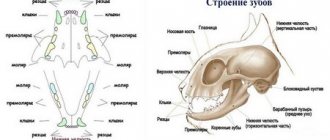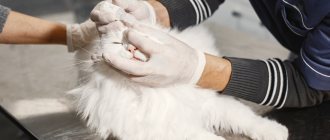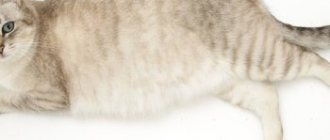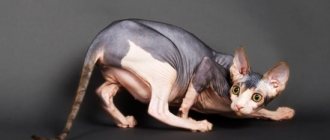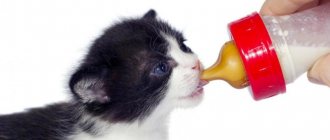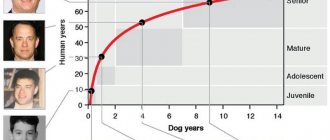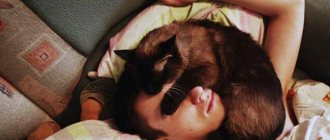Why do you need to know the age of a kitten?
It is difficult to imagine a situation where there is any practical sense in clearly establishing the age of a pet. The dosage of food or medicine for cats (as well as for people) is calculated by weight, the date of birth of breeding animals is indicated by the breeder in the accompanying documents (in the pedigree and veterinary passport), and if the kitten was picked up on the street, it doesn’t even matter. how many weeks or months old he is.
Determining the exact age of stray kittens is unlikely to make practical sense
This is how our first cat came into the house. My father brought it, warming him from the severe frost on his chest. The little creature had not yet learned to walk and swayed funny on its weak legs. The unfortunate child also did not know how to feed himself, and we took turns feeding him with milk formula from a pipette, without thinking at all about the age of our new pet. Somehow, imperceptibly, an adult robber grew out of a tiny lump, who amused himself by closing the valve in the bathroom from the inside with his paw, scaring everyone in the household to death (we thought a thief had broken in with us), in a word, the question of how many weeks the baby was originally lost its relevance very fast.
There are situations when the lack of basic ideas about what kittens look like at a given age can cause quite certain inconveniences, but this applies primarily to expensive purebred animals.
Once, a potential buyer, negotiating with the author the conditions for purchasing an Abyssinian boy, asked to send him a video in which he could see the kittens, and after studying the recording, he hesitantly asked whether the babies were really only three months old, since they supposedly looked six months old.
Three-month-old kittens differ from their parents only in size
Experts know well that by the age of three months, kittens differ from adult animals only in size, but even this difference can only be noticed when there is a “sample” nearby for comparison. The association of felinological clubs World Cat Federation (WCF) categorically does not recommend separating kittens from their mother before they reach three months of age. Because of this requirement (absolutely justified, by the way), one can often encounter a situation where, seeing in front of him not a kitten, but a small cat, the buyer believes that they are trying to sell him an overgrown animal, although in fact this is not the case.
Let's give another specific example of a situation where the ability to determine the age of a kitten by external signs will help you avoid becoming a victim of scammers.
the washing up
There is no need to wash your pet often; once every 1 or 2 months is enough. In order for the kitten to get used to water faster, it is important to provide him with comfortable washing:
- lay a rag on the bottom so that the paws do not move apart;
- make the water temperature about 38 C;
- depth - to the middle of the paws;
- the stream should be thin;
- be sure to stroke and talk to your pet affectionately (since the first bath can frighten the baby);
- Use a special shampoo for cats and rinse it off thoroughly.
The basic rule is that when washing, do not wet the kitten’s head, ears and eyes . After the procedure, wrap the animal in a soft towel and dry the fur, and then do not let the dry pet into drafts.
© shutterstock
“Whiskers, paws, tail - these are my documents”
Newborn kittens look like little worms. The length of their body, covered with delicate fur (quite a pronounced color, by the way), is no more than 10 cm, they are blind, deaf and helpless. During the first few days, the tiny lumps only sleep and eat, touchingly pushing each other with their thin paws. Babies four to five days old are still blind, but they can already hear and even react to some stimuli.
Newborn kittens are blind, deaf and helpless
Place your finger on the face of a kitten that is barely a few days old, and you will be surprised to notice how the baby tries to hiss indignantly, almost like an adult predator.
Other people's children grow up very quickly, but in cats this process happens simply rapidly. We have already said that a kitten goes from a helpless tadpole to a fully formed small predator in three months, but still we are not talking about a magical transformation, but about a consistent change. And it is precisely by how the appearance and behavior of an animal changes that one can quite clearly determine its age.
Age and size
The weight of a kitten at birth is a relative value and depends on many different factors, but on average we are talking about one hundred grams with a possible error of 10–20% in both directions.
In the following days and weeks, the babies begin to rapidly gain weight, from which it would seem that the age of the kitten can be determined by weight. There are even specially compiled tables of the relationship between these two parameters, but it is enough to compare the data given in different sources to notice how much they diverge. And this is no coincidence, because the current weight of an animal is a very individual indicator. Trying to determine the age of a kitten based on its weight is as absurd as making similar conclusions regarding a human cub.
A cat's weight depends on many factors
It is clear that the kittens of a miniature Kao Mani and a heavy Maine Coon are two big differences: at birth, their weight categories are quite comparable, but the growth of large cats is much more intense, so that by the end of the first month the gap becomes obvious. However, the weight of a growing animal is influenced not only by the breed, but also by many other factors, in particular:
- the number of babies in the litter (the more there are, the less milk each gets and the slower the weight gain);
- mother's diet during pregnancy and lactation;
- the kitten's health status;
- gender (at birth the weight of boys and girls is no different, but as they grow, males begin to gain weight a little faster than females).
We will still provide some generalized data on how quickly a kitten is gaining weight, but they are needed not to determine the age of the animal, but to answer the question of whether everything is okay with it. Everything here is the same as in humans: normal weight gain indicates that the animal is healthy and not starving.
A baby who is not gaining weight well needs to be fed extra food
During the first days of life, kittens should gain between 7 and 15 grams of weight each day, and by the end of the second week they will usually double their initial weight. Then the weight gain gradually slows down, so that up to six months the animal gains about 100 g per week.
After six months, the kitten’s growth is generally complete; a slight increase in weight in the subsequent period is possible only due to the development and strengthening of the muscles. The final formation of a cat (including puberty) ends at one and a half or two years.
Table: average normal weight of kittens of different breeds as they grow older
| Kitten age | Bengal cat, weight in grams | Maine Coon, weight in grams | British cat, weight in grams | Abyssinian cat, weight in grams |
| Moment of birth* | 70–120 | 120–160 | 60–140 | 85–110 |
| 1 Week | 170–200 | 180–260 | 110–260 | 100–200 |
| 2 weeks | 150–280 | 280–360 | 150–400 | 170–220 |
| 3 weeks | 200–350 | 420–600 | 210–630 | 200–280 |
| 4 weeks | 400–500 | 560–750 | 250–740 | 300–370 |
| 2 months | 500–1000 | 1100–1500 | 450–1700 | 750–1000 |
| 3 months | 1000–2700 | 1700–2300 | 1000–2500 | 1200–1500 |
| 4 months | 2700–3600 | 2700–3800 | 1700–3900 | 1700–2200 |
| 5 months | 2900–3900 | 2900–5500 | 2200–4300 | 1900–2800 |
| 6 months | 3900–4000 | 3200–6000 | 2300–5400 | 2100–3000 |
| Adult cat (for comparison) | 3000–8000 | 4500–10000 | 2500–7000 | 3500–5500 |
*By the end of the first day, the kitten’s weight may decrease slightly, this is not contrary to the norm.
For the reasons described above, you cannot rely on the size of the animal. Even among breeding cats, officially established standards allow significant fluctuations in “dimensions” (this is very clearly seen from the last line of the table above regarding weight limits), and we can’t even talk about yard Murks. Without knowing to what parameters the kitten intends to grow, it is impossible to determine how many weeks or months this process has already been going on.
Large size can be genetically determined in a cat
The author had the good fortune to meet an ordinary street cat of truly incredible size. He wasn't fat, he was just big! Perhaps his grandmother sinned with a caracal, but the “cat” was about 40 cm tall at the withers and overall looked no smaller than an English cocker. If it occurred to someone to determine the age of such a cat based on its size, the result would be, to put it mildly, unreliable.
The height and weight of a kitten are not the best initial data for determining its age.
Formation of teeth
Newly born kittens do not have teeth, which means their presence and degree of development can indicate the age of the baby.
In cats, like in people, the formation of teeth occurs in two stages: first, milk teeth grow, then they are replaced by molars. This complex system is explained by the fact that during the process of growth in a young animal, the formation of all organs and parts of the body continues, including the jaw, which greatly increases in size during the first year of life. To provide the animal with the ability to normally grasp and chew food, it needs teeth already in the early stages, but they cannot change along with the growth of the jaw. Nature has found a clever way out of this situation - temporary teeth and their subsequent replacement.
The kitten's incisors are the first to grow, but by the end of the first month the fangs appear.
Changing teeth (so-called diphyodontia) is characteristic of most mammals, although there are exceptions. For example, whales and so-called edentates (sloths, armadillos and anteaters) receive only one row of teeth throughout their lives. Rodents' incisors do not change; they simply grow throughout their lives, and the animal gradually grinds them down.
An adult cat has 30 molars, but only 26 baby teeth. Since they all grow in a strictly defined sequence and at the right time, here, unlike the situation with weight, the dependence on the age of the kitten is direct and obvious.
Table: the number and condition of a kitten’s teeth as it grows older
| Kitten age | Dental condition |
| 1–2 weeks | Teeth are completely missing |
| 2–3 weeks | The appearance of small front teeth (incisors) |
| 3–4 weeks | Beginning of growth of four fangs, two on top and two below |
| 5–7 weeks | Beginning of growth of primary molars (lateral teeth on the right and left sides) |
| 8 weeks | 26 baby teeth formed (full set) |
| 5–6 months | Changing baby teeth to molars in the same sequence: first incisors, then canines, then small molars and lastly four more large molars |
| 8 months | 30 permanent teeth formed: 16 on top and 14 on bottom |
It is interesting that experts quite accurately determine the age of an adult cat based on the condition of the teeth, but if, speaking about a kitten, attention should be paid to the very presence of certain teeth, then in a “well-worn” animal these most important organs begin to turn yellow, wear out and then fall out, and also in a strictly defined sequence.
It should be recognized that the teeth are the most reliable indicator of the age of an animal; another thing is that only a specialist can “read this book” correctly. Of course, it is relatively easy to catch a kitten and, looking into its mouth, count its fangs and incisors (however, try!), but the answer to the question of whether they are deciduous or molar can cause difficulties.
The number and condition of teeth allows you to most accurately determine the age of a kitten
We can talk for a long time about the external differences between permanent and temporary teeth, but let’s be honest: if you are not a professional breeder, do not look for obvious answers in the mouth of your tailed pet.
Other external "markers"
The standard for each cat breed describes a lot of characteristics that the animal must meet. Moreover, any specialist knows well that they all form gradually, which is why self-respecting experts never evaluate kittens, at least until they reach three months of age. But this rule can also be looked at from the other side: depending on how formed the animal is, one can judge its age. Here, anything can act as a marker - eyes, ears, fur, proportions, etc.
Eyes
The easiest way to determine the age of a kitten from birth to two weeks is by looking at its eyes. Blind at birth, babies begin to “see” between the first and second weeks of life, and by 15 days of age they are already looking at the world.
So, at first everything is very simple:
- if the eyes are tightly closed, the kitten is from one day to a week old;
- if the eyes begin to open (one at a time, from the corner on the side of the bridge of the nose) - a baby from a week to ten days;
- If the eyes are completely open, the kitten is at least 10 days old.
Kittens' eyes open no earlier than 10 days of age.
But then the subtleties begin. All kittens, regardless of breed, initially have a dull dark blue eye color.
Dark blue eye color is temporary, it will soon change dramatically
Starting from the third week, children’s “look” gradually becomes clearer, and around the end of the second month, the eye acquires the “proper” color. In different breeds, this process may occur in a special way, in addition, up to a year, some changes in shade are possible, but the general trend is exactly this.
It is worth noting that some cat breeds (for example, Siamese) always have blue eyes, that is, they do not seem to change color. But anyone who has at least once seen the huge dark eyes of a two-week-old kitten will confirm: this shade cannot be confused with anything else.
Ears
Newborn babies' ears look like small rags, located not on top, like adult cats, but almost on the sides of the head.
Newborn kittens' ears are located on the sides of their heads.
They are soft, barely noticeable and almost pressed against the skull, in a downward diagonal direction. The process of ear formation begins in the second week. The pinnae gradually open and the ears slowly move into the correct position on the head, enlarged and elongated, but still remain disproportionately small and noticeably more rounded than on an adult cat. By the end of the sixth week, the kitten’s ears are already in their place, but these organs acquire their final shape in the same notorious 3 months.
The kitten’s ears gradually straighten and take on their proper shape.
This, of course, does not apply to fold-eared cats; these animals have their own history. The folding of ears in Scottish Folds occurs in the second to fourth week of life (the period from the 18th to the 20th day is considered especially important, usually at this moment it is decided whether lop ears will appear), but this process is very individual. The ear can rise, like a normal cat's, but gradually a bend begins to form at its tip, descending more and more downward.
In lop-eared kittens, the ears do not rise, but rather fall down.
In general, the rule is the same for everyone: ears on the sides mean that the kitten is less than three weeks old, ears on the top of the head mean at least one and a half months.
Wool
In popular articles you can often find bravura statements that the age of a kitten can be determined by the condition of its fur, but no one explains exactly how to do this. Indeed, kittens are not born naked; hair is initially present on their bodies. Moreover, we note that this is wool, and not down, because it contains both types of hair - guard and down.
And yet, the undercoat (fluff) of babies is noticeably larger than that of adult cats, and this is very noticeable to the touch. The animal’s body is completely overgrown with dense, straight, hard and long hairs by five to eight months, which is preceded by the first molt.
Not all cats have fur
There are, however, cats whose coat condition changes as they grow up so much that it can be determined not only by touch, but also visually. First of all, we are talking about ticking - a special color, which is characterized by alternating several shades along the length of each guard hair.
A three-month-old Abyssinian has clearly visible ticking
The most prominent representatives of ticked cats are the Abyssinians. Ticking begins to form in the third month of a kitten's life; in babies, the guard hairs do not have a pattern.
Proportions
As already mentioned, in just three months the kitten’s appearance changes dramatically: from a disproportionate creature with a huge head, thin legs and an impressive belly, the baby turns into a graceful predator with strong muscles. The state of this transformation can also be used to judge the age of the kitten.
A one-month-old kitten has a large head and short legs
So, by the age of one month, the baby’s limbs are already quite strong, but short and thick, and the head still remains disproportionately large. Gradually, the paws stretch out, the entire body increases in size, and the animal becomes closer to the adult standard.
Ear cleaning
Ear care for kittens at 2 months does not need to be done frequently, as their shells are usually still clean. But checks for the presence of earwax (dark spots) should be carried out from time to time. Dirt should be removed as needed with a cotton swab lubricated with oil or cosmetic Vaseline.
When cleaning, you should not try to insert the stick deep into the ear; it is enough to remove accessible stains. When carried out properly, almost every kitten tolerates the procedure calmly . This procedure is not only hygienic, but also an excellent preventive measure against ear mites. Cleaning should be done individually (depending on how dirty it is), but on average – once a month.
© shutterstock
Determining age by behavior
How strange: spoiled children, especially strangers, usually cause us irritation; at best, we do our best to restrain ourselves, trying to be tolerant. But looking at the raging kittens, ready to destroy the whole house in their noisy games, a stupid, touching smile stretches even the faces of stern people.
Kitten games are always a delight
One day, an indignant neighbor rang the author’s doorbell, haunted by the constant roar coming from above. Having crossed the threshold, the man looked for several minutes at the three-month-old kittens, selflessly chasing an empty plastic bottle around the floor, then thoughtfully asked: “How much does it cost?” - and went for the money.
Determining the age of a kitten by its behavior is much more pleasant than looking into the mouth of a small predator and counting its teeth.
Learning to walk
Babies take their first hesitant steps towards the end of the second week of life. At first, it is difficult for them to maintain balance; they sway funny even when sitting, and when they rise to their feet, they have difficulty supporting their plump body on them. Gradually, the forays from the nest become more and more distant, and finally, the bravest one completes the inspection of the entire house.
Between two weeks and a month, babies learn not only to walk, but also to run, jump and climb vertical surfaces using their claws. Having fallen from a height (for example, from a sofa), the baby no longer plops down on the floor with his whole body, but gracefully lands on his paws, deftly turning around in the air.
Month-old kittens run around the house like mad, often knocking over objects in their path.
Hunting is the most important skill for a kitten
By two months, children gradually master hunting skills, their movements and games become more and more “adult”.
From three to six months, the childhood age of small cats is revealed only by excessive activity and immoderate curiosity. By the way, it is during this period that animals often get into trouble, sometimes ending in tragedy.
The author had to endure several terrible hours when his four-month-old cat, having inexplicably slipped through the opened door, decided to explore the new territory and fell into the open hatch of the garbage chute, flying nine floors. Fortunately, the landing was successful: the janitor heard a plaintive meow, and the prodigal daughter was returned to her family.
Learning to eat
As mentioned, WCF strongly recommends that kittens not be separated from their mother until they are three months old. All this time, babies continue to receive mother's milk, but starting from eight weeks, this process is more an element of family communication than nutrition.
They say that kittens need to start switching to solid food at about a month of age, but the author has never had to do this: babies are remarkably “transferred” to adult food on their own when one of them first wanders into the kitchen in search of their mother and discovers her in front of a fragrantly smelling plate.
A month-old fidget will find a bowl of “adult” food on its own
One way or another, kittens begin to feed on their own (lapping and grabbing pieces of food with their teeth) from the ninth week. By this time, as we remember, they have already formed a full row of baby teeth. So, if your baby is pointlessly poking at his plate, he is most likely not yet eight weeks old.
As soon as the kitten begins to receive other food in addition to mother's milk, it is time to accustom it to the tray. Breastfed babies are licked by the cat herself, so they do not need the toilet.
In conclusion, it is worth noting that the speed at which kittens acquire all the above skills largely depends on whether there is an object to imitate nearby. The WCF requirements about the need for kittens to stay in a “full family” for a sufficiently long time are dictated precisely by the fact that for the correct formation of a cat’s character, receiving full maternal education is very important. A puppy can be taught everything necessary by a person, but in cats this function belongs to the mother.
No one can teach a kitten everything necessary for life better than its mother.
This means that if you pick up a helpless baby on the street who can neither walk nor feed himself, perhaps he will learn all this a little later than expected, so when determining the age of your pet, make allowances for his “difficult childhood” .
Video: two-month-old kittens playing next to their calm mother
Often, the age of a kitten is a closely guarded secret (unless, of course, you were personally present at its birth). But by looking closely at your pet, you can break these seals one by one. External signs (weight, size, presence and number of teeth, eye color, ear shape, coat condition, proportions), as well as behavioral characteristics should be used as “keys”. Not all of the mentioned tips have the same degree of reliability and information content, but if you study them together and correctly compare the results, the answer you receive will be very close to the truth.
Teeth cleaning
2 months is the age when it is easiest to teach a kitten to brush its teeth. The later you start, the more difficult it will be to force your pet to endure the execution.
It is enough to take care of your pet’s teeth only 1-2 times a month; the rest of the time, the kitten cleans off the plaque itself by gnawing on solid food (dry croquettes, chicken or meat cartilage, etc.).
When caring for your teeth, it is better to use special brushes and pastes with the smell and taste of your favorite foods that are attractive to pets, as this makes it much easier to get used to the procedure. You can buy everything you need at veterinary pharmacies.
Advice: it is better to end each dental care session with praise and treats to reinforce the training effect.
What not to feed a kitten
It is very important to feed your kitten correctly. Proper feeding of the baby from childhood is the key to health in adulthood.
Contrary to popular belief, kittens should not be fed whole milk, neither cow's nor goat's. Most kittens do not digest the lactose contained in milk, and adult cats develop natural lactose intolerance as they age. The mysterious substance lactose is a type of sugar. Whole milk in the diet can lead to serious gastrointestinal problems such as stomach cramps and diarrhea. In addition, pets do not receive any beneficial substances from milk. Alternatives are ready-made formulas for small kittens or homemade milk formulas.
In no case should you neglect the rule: do not feed the kitten from the table. Human food contains excess fats, seasonings and spices that are not suitable for a cat's body.
Fatty meat and fatty trimmings in the diet lead to the development of pancreatitis and liver problems.
Bones can seriously injure the esophagus and gastrointestinal tract.
Sweets provoke the development of liver failure and diabetes.
Pork and sausage can cause pancreatitis, liver cirrhosis and acute kidney failure.
Raisins and grapes cause poisoning.
Character of British cats
British kittens become practically independent from their owner from an early age. They can stay alone for a long time and not get bored. One should not expect excessive affection and tenderness from animals; they have a rather cold temperament. However, oddly enough, this does not mean that they do not love their owners and are not attached to them. The British will always accompany them because they want to be nearby.
Cats will not break out of your hands or resist, but will calmly withstand all attacks of tenderness from their owners.
Basics of proper nutrition
When deciding how to feed a one-month-old kitten, you need to decide whether in the future it will eat ready-made factory feed or natural food. The pros and cons of both feeding options have been controversial for a long time. Mixing both types of feeding is not recommended. And there are objective reasons for this: different types of food are digested in different ways and for different amounts of time. An animal eating dry food needs more water.
It may not be easy to immediately choose the right nutrition among commercial feeds: ready-made feeds can differ greatly in composition. It is not recommended to mix food of different brands, as this can cause an oversaturation of the body with microelements and vitamins. The consequences of poor nutrition can be serious problems with digestion and gastrointestinal tract.
Even having decided on the option of feeding the baby, there are a number of rules that are important to follow:
- Feeding a one-month-old kitten should be divided into 6-8 servings. At the same time, you need to make sure that your pet does not overeat. The serving size should take into account the food option (natural or dry), as well as the breed and future size of the adult.
- New foods are introduced into the diet separately and gradually. Monitor your cat's reaction to each new product introduced. If problems with digestion or stool occur, the introduction of this product should be postponed.
- If you are feeding natural foods, you may need to add vitamins to your diet. But it is still recommended to consult a veterinarian first.
- And the most important rule is that the chosen feeding option must be of high quality.
Wool
Shiny and soft fur is an indicator of the health of the animal. In order for her to always look “excellent”, she will need comprehensive care:
- balanced diet;
- keeping the kitten clean (timely washing);
- and actually caring for your pet’s fur coat – combing with special combs and combs (not human ones).
To care for a 2-month-old kitten’s fur, it is important to meet all of the above conditions.
Recommendation: a comb, with its teeth, penetrates the hair much deeper than a comb, so when using it, you should not apply pressure.
Security
A kitten in the house, regardless of age, requires compliance with certain rules of behavior from family members.
First of all, you need to block off all places that are difficult for humans to reach: if the kitten gets stuck somewhere, you will not be able to help him. Therefore, the places under and behind sofas and cabinets are at risk: it is better to cover them with something. Folded blankets or scrap rags will do.
The apartment must be clean and safe. Chemicals should be removed from wherever a little explorer can reach. This also applies to medications. Check all corners and niches for stray food, toys or small parts. Cleanliness is a guarantee of safety. Make sure your kitten can't eat, drink, or get into anything toxic.
Remember that kittens often sleep in the most unpredictable places. Check where you plan to go next in your life. The same applies to moving heavy objects, opening and closing doors, cabinets, and drawers.
Don’t leave him alone with electrical appliances turned on and remember that a vacuum cleaner and hair dryer are the worst enemies for a cat’s delicate hearing. If he gets scared, he will have to search for a long time.
Until the little miracle begins to climb out of the box on its own, these tips for caring for a kitten may not be needed, but then you can’t do without them.
In fact, many cats remain kittens until old age. Although often, when they grow up, they leave the spontaneity and playfulness of childhood. Catch the moment before your cat becomes a sedate matron and enjoy her antics to the fullest. And remember that forgetting about caring for a kitten up to 12 months old is simply criminal.
